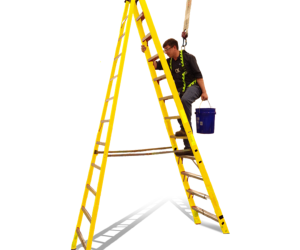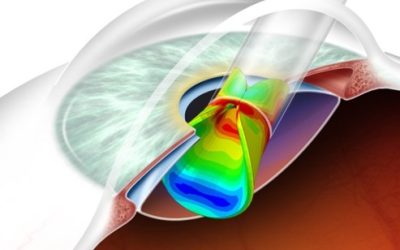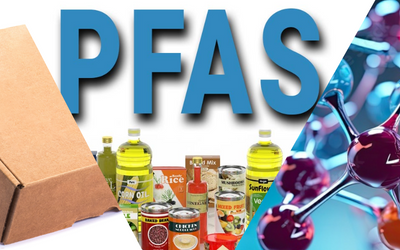European Union Sustainability Directives
The EU has made a very strong regulatory commitment to sustainability improvements via the implementation of the Digital Product Passport (DPP) and the Package and Packaging Waste Directive (PPWD). The provisions of the PPWD are designed to reduce the disposal of packaging waste and to promote a more circular economy. (Revision of the Packaging and Packaging Waste Directive (europa.eu) Although there are many public and private initiatives in the US aimed at sustainability improvement, they are not as comprehensive and they are not mandated by law.

A recycling box filled with containers
Regarding sustainability, the European Union and the United States are coupled. Multi-national consumer products goods companies (CPG) global packaging organizations and development processes are shared and, in the EU, are under mandate to advance more sustainable packaging solutions on a defined timetable. The State of California has introduced legislation that closely mirrors features of the PPWD. California Initiative Promotes Milk Jug Recycling | Packaging World (packworld.com) However, the global packaging industry cannot satisfy the comprehensive scope of the EU requirements until package forms and packaging waste strategies are developed that are robust, functional, and cost-effective in both the ecommerce and conventional Bricks and Mortar distribution modalities.
Current Package Development Methods and Strategies Won’t Deliver
The current packaging design and development environment is founded on strategies, guidelines, and methods that have been developed to satisfy the consumer needs and the distribution challenges encountered over the past 60+ years. In general, packaging has been optimized to deliver consumer benefits for the lowest cost. (Do Marketing and Packaging Structure Go Hand-in-Hand? | Packaging World (packworld.com) Although lowest cost is typically aligned with sustainability improvement, the materials, structures, strategies, and data that will be needed to support the development of packaging systems and formats that will satisfy the changes needed to meet the new EU regulations are not part of the current experience of package and packaging systems developers. The packaging challenges that must be faced to achieve the objectives outlined in the PPWD are far more complex than they were in the past because two very different distribution modalities exist today, ecommerce and Bricks and Mortar. The scope of sustainable packaging solutions that will satisfy both of these product distribution modalities is often divergent and, in some situations, mutually exclusive.
Liquids Packaging: A Posterchild of The Sustainability Packaging Challenge
Liquids packaging has typically been designed to be transported is groups of 3, 6, 8 or 12 identical units standing upright in a corrugated case or tray to a store where it is placed upright on a shelf. The packages typically have a shape and features that offer some form of benefit to the consumer and have a broad label panel that supports brand positioning. About 99.5% or so, of the time these packages are delivered to the consumer without damage or leakage.
The distribution of these same packages via ecommerce are the poster children of damage, leakage, and failure. Today, it is not uncommon to see individual liquid products shipped in their primary container, a bottle and closure, sealed in a plastic over bag, “just-in-case” it does not survive and expels some or all of the liquid as a result of the unique and unstructured challenges of parcel delivery. These failures are not a result of bad packaging, they are a result of packaging being optimized to satisfy a different set of requirements. At a minimum, the additional plastic bag and the effort that went into its manufacture and application to the bottle are counter to all sustainability initiatives. The true sustainability tragedy is if the bottle or closure system fails, the liquid is expelled and unusable, the consumer is angry, and a replacement product is provided by the manufacturer to overcome the consumer’s loss. The sustainability loss in this, not all that uncommon scenario is huge.
The world has not remained stationary as ecommerce has gained popularity. Test methods such as ISTA 6-Amazon were conceived to be an initial step to evaluate the ecommerce delivery worthiness of existing and emerging ecommerce packaging, but it is just a start. ISTA, Your Alliance in Transport Packaging, is the world leader in Performance Tests for Packaged-Products There are improvements that can be made but it will take time for industry to assess and adopt.
A Secret Truth for Transition to Successful Sustainable Packaging
Ultimately the consumers of products have added sustainability to their list of desires and demands that leading consumer goods companies must satisfy to earn each and every product sale. The EU is responding to the “voice of the consumer” (VoC) through very prescriptive and challenging legislation, which influences what is and will happen in the United States. What is the Voice of the Customer | Microsoft Dynamics 365 However, the consumer also added the conveniences of ecommerce to the wish list of benefits the CPGs must deliver on. Implicit in the ecommerce demand is packaging that must meet sustainability goals and arrive intact and functional at their doorstep. This is where the collision occurs between the old and new world of package development. The thought processes, strategies, and methods that delivered the amazing, consumer-driven packaging of yesterday must evolve to a new level of packaging science and development.
ASSOCIATED REFERENCE: The European Green Deal and It’s Impact on CPG (White Paper, 2023)
AUTHOR
 Clint Haynes, founder of the Cincinnati office of Stress Engineering Services, has steadily grown the Cincinnati practice area while introducing breakthrough capabilities. He has a specialized focus on areas of medical, outdoor, and product innovation.
Clint Haynes, founder of the Cincinnati office of Stress Engineering Services, has steadily grown the Cincinnati practice area while introducing breakthrough capabilities. He has a specialized focus on areas of medical, outdoor, and product innovation.
Ref: B0011-SP DPP Blog Pkg Challenges Facing CPGs
Keep in touch with us.
Sign up for our newsletter.



